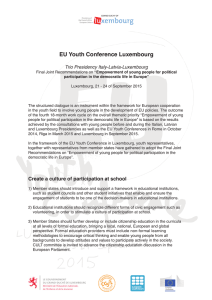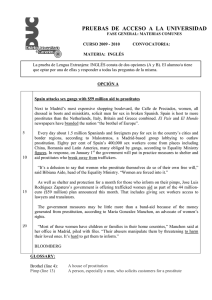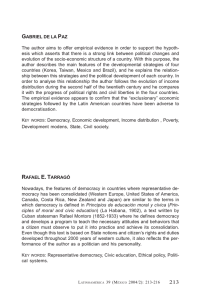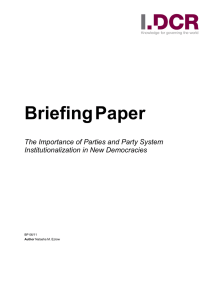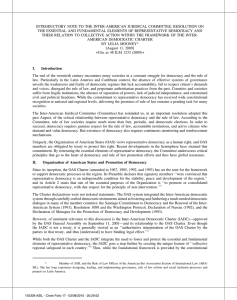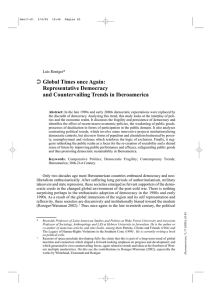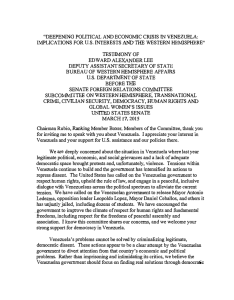Democracy, Minority Rights and Conflict Prevention in
Anuncio
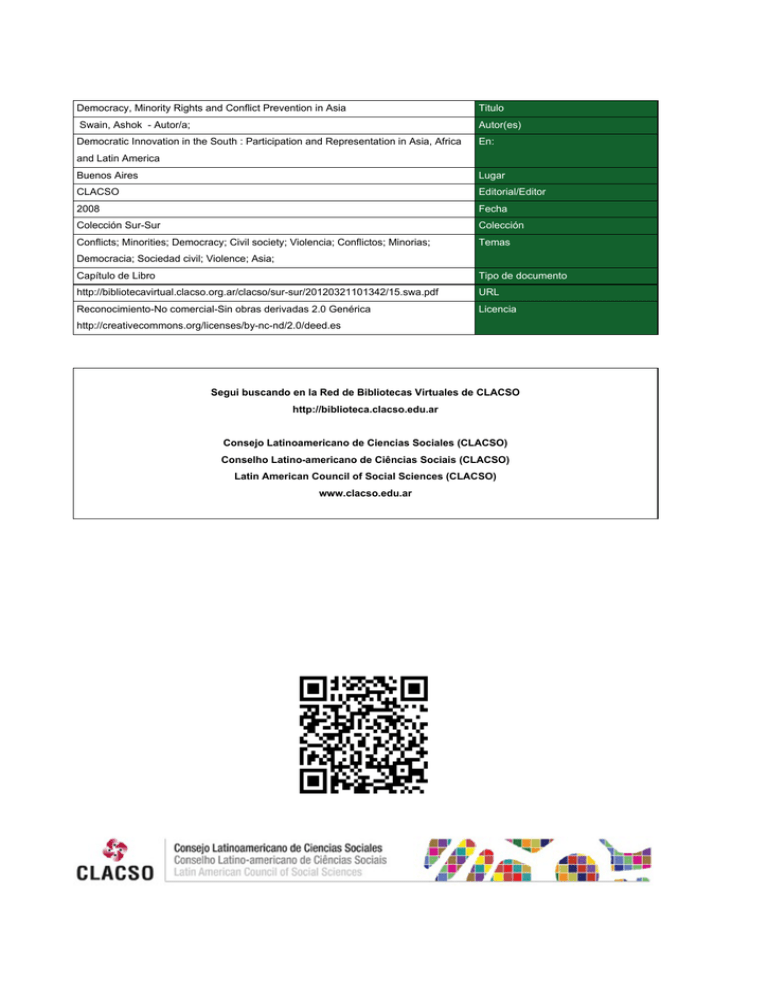
Democracy, Minority Rights and Conflict Prevention in Asia Titulo Swain, Ashok - Autor/a; Autor(es) Democratic Innovation in the South : Participation and Representation in Asia, Africa En: and Latin America Buenos Aires Lugar CLACSO Editorial/Editor 2008 Fecha Colección Sur-Sur Colección Conflicts; Minorities; Democracy; Civil society; Violencia; Conflictos; Minorias; Temas Democracia; Sociedad civil; Violence; Asia; Capítulo de Libro Tipo de documento http://bibliotecavirtual.clacso.org.ar/clacso/sur-sur/20120321101342/15.swa.pdf URL Reconocimiento-No comercial-Sin obras derivadas 2.0 Genérica Licencia http://creativecommons.org/licenses/by-nc-nd/2.0/deed.es Segui buscando en la Red de Bibliotecas Virtuales de CLACSO http://biblioteca.clacso.edu.ar Consejo Latinoamericano de Ciencias Sociales (CLACSO) Conselho Latino-americano de Ciências Sociais (CLACSO) Latin American Council of Social Sciences (CLACSO) www.clacso.edu.ar Part IV Minority rights and Democracy Ashok Swain* Democracy, Minority Rights and ConflictPrevention in Asia Why do democracies encounter more violent secessionist movements in comparison to non-democracies? While there is evidence that democratic states contribute to international peace, the converse, that democracies enjoy internal peace, seems problematic. In fact, the evidence seems to suggest that authoritarian states face fewer separatist challenges of a violent nature than do democratic ones. Democracy, which introduces competitive elections, is commonly offered as a solution to political problems. However, in ethnically divided societies, competitive democracy may exacerbate political tension and polarize groups. Are systems of democratic governance incompatible with durable peace in such societies? This work examines how respect for minority rights can contribute to conflict prevention in multi-cultural democracies in Asia. Democracy, Peace and Conflict Since the end of the Cold War in Europe, the notion that democracy is the ideal form of government has almost become axiomatic, though the empirical evidence for such a normative conclusion is not yet de* Professor of Peace and Conflict Research, Uppsala University, SWEDEN. Author is grateful to Sabil Francis and Erin Mooney for their research support. 213 Democratic Innovation in the South finite. Closely related is the belief that a community of democratic nations is the best way to maintain domestic and international peace. There is considerable evidence for the democratic peace in international relations, and democracy, or the promise of democratization, has been an integral component in several peace agreements since the end of the cold war, that have ended civil conflict within nations. In the last two decades, several countries, in Asia, Latin America, and Eastern Europe, have become democratic. The on-going third wave of democratization began in Southern Europe in the mid 1970s, moved on to Latin America and Asia in the 1980s, and in the 1990s, reached sub-Saharan Africa, Eastern Europe and the Soviet Union. This wave, rather tsunami, of democratization, like previous ones is not a smooth and straightforward one. Some countries, like Pakistan and Thailand have also reverted back to military dictatorship. The international donor community is committed to democracy, most importantly by promoting civil society. This commitment may have suffered some serious handicaps after 9-11, but it has still remained the main mantra of the aid agencies. Implicit in the literature on democracy is also the idea that a democratic government is the best way to manage conflict, both internal and external. In fact, as Shapiro and Cordon point out, “there is a strong propensity to associate democracy with a wide array of activities and outcomes that people value.” Most of the literature on democracy assumes that it is the best form of government. In fact, in contemporary popular and academic discourse on Afghanistan and Iraq, the mere imposition of democracy was prescribed as the most important step towards peace. Theoreti Russet, Bruce, Grasping the Democratic Peace (Princeton University Press, 1993); Wallensteen, Peter, Understanding Conflict Resolution: War, Peace and the Global System, London: Sage Publications, 2002; Spencer, Weart, Never at War: Why Don’t Democracies Fight One Another? New Haven: Yale University Press, 1998; There are some works, which are critical to this democratic peace concept: Bermer, Stuart A, “Dangerous Dyads: Conditions Affecting the Likelihood of Interstate War, 18161965”, Journal of Conflict Resolution, Vol.36, No.2 (1992); Babst, Dean and William Eckhardt. “How Peaceful Are Democracies Compared With Other Countries,” Peace Research 24 (1992) pp. 51-57; Henderson, Errol A., Democracy and War: The End of an Illusion (Lynne Rienner Publishers, Boulder, 2002). Huntington, Samuel, “How Countries Democratize” Political Science Quarterly 106 (4) 1992: 579-616. Huntington, Samuel, The Third Wave: Democratization in the Late 20th Century (Norman, University of Oklahoma Press, 1991). Potter, David et al. Democratization (Cambridge: Polity Press, 1997). Shapiro, Ian and Casiano Hacker Cordon (eds) Democracy’s Value, (Cambridge, Cambridge University Press, 1999). Goodson, Larry P, “Afghanistan’s Long Road to Reconstruction” Journal of Democracy - Volume 14, Number 1, January 2003, pp. 82-89. 214 Ashok Swain cal work on democratic transition and democratization has also emphasized the conflict resolution capacity of democracy. Poe and Tate’s conclusion that there is a negative relation between democracy and the level of repression has been elaborated in several works. In contemporary academic and popular discourse, the idea that democracy, as such, rather than any other form of government, is the best way to resolve inter-state conflicts has been stressed. According to Linz and Stepan, “democracy has become the only game in town when no significant political groups seriously attempt to overthrow the democratic regime or secede from the state.” Several theorists have also extended the democratic peace thesis to argue that a “democratic peace” is evident within intra-state conflicts as well.10. It has been reasoned that democracy reduces the likelihood of discrimination, especially of ethno-political minorities, and thus the likelihood of political repression.11 However, as Errol A. Henderson points out, “the democratic peace proposition” has not been explicitly tested with reference to third world post-colonial states, where most civil wars take place.12 In recent years, research has attempted to explain why the new democracies have not been able to benefit from the values of democracy. Recently, Thomas Carothers argued, “Many countries Poe, Steven C., and C. Neal Tate, “Repression of Human Rights to Personal Integrity in the 1980s: A Global Analysis,” American Political Science Review, vol.88, no.4: pp.853-872. Henderson, Conway, “Conditions Affecting the Use of Political Repression”, Journal of Conflict Resolution, 35: 1991, 120-142; Mitchell Neil, and James McCormick, “Economic and Political Explanations of Human Rights Violations”; World Politics 40: 476-98; Ziegenhagen, Eudard, The Regulation of Political Conflict (New York: Praeger, 1986). Again, there is criticism of the idea that democratic government will automatically bring peace but this remains a minority view. Pinkney, Robert, Democracy in the Third World, Lynne Rienner, (Colorado, Boulder: 2003); Reiter, Dan, “Why NATO Enlargement Does Not Spread Democracy” International Security, 25, 4 (Spring), pp.41-67. Linz, Juan J & and Alfred Stepan, Problems of Democratic Transition and Consolidation: Southern Europe, South America, and Post Communist Europe (Baltimore: John Hopkins, 1999), p. 5. 10 Matthew, Karin and Marissa Myers. 1997. ”Democracy and Civil War: A Note on the Democratic Peace Proposition”, International Interactions, 23, 1: pp.109-118; Rummel, R.J,. “Libertarian Propositions on Violence Within and Between Nations: A Test Against Published Research Results,” The Journal of Conflict Resolution, Vol. 29 (1985) pp. 419-455. 11 Gurr, Ted, ed. Minorities at Risk: A Global View of Ethnopolitical Conflict (Washington DC, US Institute of Peace, 1993). 12 Henderson, Errol A., Democracy and War: The End of an Illusion (Lynne Rienner Publishers, Boulder, 2002). 215 Democratic Innovation in the South that policy makers and aid practitioners persist in calling “transitional” are not in transition to democracy, and of the democratic transitions that are under way, more than a few are not following the model.”13 The latest contribution to the debate has been the argument that a new form of government, “semi-authoritarian14” has emerged in the new democracies that rose in the third wave of democratization, and that such “semi-authoritarian” states, rather than representing a transitory phenomenon, are a new political phenomenon in themselves. Such states exhibit the characteristics of both democracies and authoritarian states. They combine rhetorical acceptance of liberal democracy, the existence of some formal democratic institutions, and respect for a limited sphere of civil and political liberties with essentially non-liberal or even authoritarian traits. As Ottaway explains, they “maintain the appearance of democracy without exposing themselves to the political risks that free competition entails.”15. Others have termed the new democracies “pseudo-democracies”, “semi-democracies”, or “hybrid democracies”.16 They argue that such “semi-democracies” are more prone to violence than authoritarian or fully consolidated democratic states, which have been conceptualized as being the two ends of the democratic spectrum. Fein argued that the most repressive states are those that exhibit intermediate levels of democracy, the “semi-democracies”, the idea that dominates the debate today.17 Another explanation, similar to the “semi-authoritarian” thesis, is that there has been that a “premature closure” of the transition process –through the establishment of formal procedures 13 Carothers, Thomas, “The End of the Transition Paradigm” Journal of Democracy, Volume 13, Issue 1 (2002) pp. 5-21. Quote in page 6. For a lively debate on the Transition paradigm see Journal of Democracy Volume 13, Issue 3 (2002). 14 Brumberg, Daniel, “Democracy in the Arab World? The Trap of Liberalized Democracy” Journal of Democracy, Volume 13, Number 4 October 2002. 15 Ottaway, Marina S. Democracy Challenged: The Rise of Semi-Authoritarianism, Washington, DC: Carnegie Endowment for International Peace, 2003. Ottaway argues that such regimes abound in former Soviet successor states like Kazakhstan and Azerbaijan, in sub-Saharan Africa. In these countries, most of the multiparty elections of the 1990s failed to produce working parliaments or other institutions capable of holding the executive even remotely accountable. Such regimes exist in the Arab world, in the Balkans, and in Latin America, where she argues that Venezuela and Peru have regressed to this state of affairs. In Asia, she classifies the states of Malaysia, Singapore and Pakistan as “semi-authoritarian” states. 16 Håvard, Hegre, et al, 2001. “Toward a Democratic Civil Peace? Political Change and Civil War, 1816-1992”, American Political Science Review, Vol.95, No.1, March. 17 Fein, Helen “More Murder in the Middle: Life Integrity Violations and Democracy in the World, 1987” Human Rights Quarterly 17, 1: 170-191, 1995. 216 Ashok Swain and institutions, before a real change in the nature of power– has taken place.18 However, these explanations, still bypass the essential question, as to whether democracies sharpen or lessen ethnic division by conceptualizing an “ideal” democracy, and then trying to explain anomalies that rise from this. Moreover, the “semi-authoritarian” conception, while being an important contribution to the literature on democracy, does not explain why a number of consolidated democracies, like India, Turkey, Sri Lanka, Israel or even the UK and Spain face violent separatist challenges within their state borders. Thus, current literature has focused on the transition paradigm, or on an attempt to define a particular democratic polity as imperfect, while keeping the ideal of democracy intact. Such an approach, however, is not able to explain a crucial point. Why have democracies, even consolidated ones, witnessed violent separatist movements? Countries that are mature and stable democracies –and with an inclusive form of society– such as India, have even faced several violent separatist challenges. This goes against the prevailing notion of the co-relation between democracy and internal peace. Several research works have already pointed out that the type of political system sharply affects the nature of protest in a state. The democracies are supposed to have more extensive but less deadly protest than the autocracies.19 The structure and ethos of democratic regimes are such that they are adjusted to respond to limited challengers in a conciliatory way, which reinforces the utility of protest over rebellion for the opposition groups. On the other hand, authoritarian regimes generally rely more on coercive control, which increases the relative utility of rebellion for challengers. It has been argued that the extent of political repression depends on the level of threat faced by a government,20 and that democracies repress less as they face different types of threats when compared to autocracies, or because they did 18 Ohlson, Thomas, and Soderberg, Mimmi, From Intra State War to Democratic Peace in Weak States, Uppsala Peace Research Papers Number 5, Department of Peace and Conflict Research, Uppsala University, Sweden, 2002, p.5. 19 Gurr, Ted R. “Why Minorities Rebel: A Global Analysis of Communal Mobilization and Conflict since 1945” International Political Science Review, vol. 14, no. 2, 1993; Swain, Ashok, Social Networks & Social Movements: Are Northern tools Useful to Evaluate Southern Protests, Uppsala Peace Research Paper No. 4, 2002; Zimmermann, Ekkart, “Macro–Comparative Research on Political Protest”, in Ted R. Gurr, ed., Handbook of Political Conflict: Theory and Research (New York: Free Press, 1980), pp. 167-237. 20 Gartner, Scott S. and Patrick M. Regan, “Threat and Repression: The Non Linear Relationship between Government and Opposition Violence”, Journal of Peace Research 33: 3, 273-288, 1996. 217 Democratic Innovation in the South not view dissent as threatening to the regime.21 Ronald A. Francisco’s empirical evaluation of the relationship between coercion and protest in three coercive states (the German Democratic Republic, Czechoslovakia, and the Palestinian Intifada) finds that the protesters react violently to extremely harsh coercion.22 It is true that democracies have not faced, in general, rebellions that have regime change as their aim, but rather secessionist movements. According to the Uppsala Conflict Data Project, Russia, Turkey, India, Indonesia, Sri Lanka, Senegal, Philippines are among the democracies that faced separatist violence. There is no doubt that democracies face more separatist violence than non-democracies. Even several “mature” democracies are facing a number of violent separatist challenges at present or they have faced in the recent past. Certainly, there is a “dearth of practical advice for policy makers on how to design and implement democratic levers that can make peace endure”.23 It is important to closely examine why democracies do not experience rebellions for the regime change but at the same time, they have been facing violent separatist conflicts. A thorough research undertaking requires evaluation across the spectrum of nondemocratic, semi-democratic, or democratic states. This paper tries to examine how democratic process contributes to the internal conflict escalation and conflict resolution, particularly in Asia. Democracy and People There is the debate between whether democracy must be defined in the most minimal way, or if it should be defined as all encompassing. One of the most basic definitions of the concept has been the minimalist definition of the Italian philosopher Norberto Bobbio, that democracy is in essence, the replacement of the power of persuasion over that of force.24 As he put it, “What is democracy, other than a set or 21 Davenport, Christian, “Human Rights and the Democratic Proposition”, Journal of Conflict Resolution, 43, 1: 92-116, 1999. 22 Francisco, Ronald A., “The Relationship Between Coercion and Protest: An Empirical Evaluation in Three Coercive States” Journal of Conflict Resolution, 39:2 (June 1995):263-282. However, by bringing in the role of international context and the importance of press freedoms and information flows, Kurt Schock finds, in a comparative study of the Philippines and Burma, the excessive repression of authority might able to curb the popular protest. Schock, Kurt, “People Power and Political Opportunities: Social Movement Mobilization and Outcomes in the Philippines and Burma”, Social Problems, vol. 46, no. 3, August 1999, pp. 355-375. 23 Harris, Peter and Reilly, Ben(eds),, Democracy and Deep Rooted Conflict: Options for Negotiators, Stockholm: International IDEA Handbook, 1998. 24 Zolo, Danilo, Democracy and Complexity: A Realist Approach (Polity: Polity Press, 1992), p. 99. 218 Ashok Swain rules, for the solution of conflict without bloodshed?”25 The classic definition by Schumpeter26 was that democracy was merely a system in which rulers were selected by competitive elections, while Popper27 defined it as a means by which people removed rulers without resource to force. In contrast to this minimalist expectation, Dahl’s concept of “polyarchy” asks for the presence of elected officials, free and fair elections, inclusive suffrage, the right to run for public office, freedom of expression, existence and availability of alternative information, and associational autonomy, as essential to democracy.28 Diamond also supports Dahl’s framework in his work.29 However, in democratic states that face violent separatist conflict, neither the minimal nor the all-encompassing models seem to have the desired effect. In other words, despite the manner in which democracy is defined, there is a possibility of separatist conflict. And the exact definition of democracy is still contested in many transitory democracies that face numerous challenges such as the need for popular legitimacy, the shallow roots of democratic values, weak party systems, organized factional interests and complicated electoral rules. Such systems also struggle with the customization of politics, the decentralization of state power, the introduction of mechanisms of direct democracy, judicial reform, the alleviation of poverty, and economic stabilization, to name just a few of the trials that they face.30 Przeworski argues that majoritarian politics do not converge on common interests, in modern polities, and that elections do not represent the general will.31 Democracy can be defined as a system where the government is in power by the consent of the people and the government is accountable to the governed. All these are crucial, and the denial of one of these leads to a crisis of legitimacy of the state. In fact, 25 Shapiro, Ian and Casiano Hacker Cordon (eds) Democracy’s Value, (Cambridge, Cambridge University Press, 1999), p. 23. 26 Schumpeter, Joseph A., Capitalism, Socialism and Democracy (New York: Harper & Brothers, 1942). 27 Popper, Karl, The Open Society and its Enemies (London: Routledge and Kegan Paul, 1962). 28 Dahl, Robert A., Preface To Democratic Theory (Chicago: University of Chicago Press, 1956). 29 Diamond, Larry Developing Democracy- towards consolidation (John Hopkins University Press,1999). 30 Schedler, Andreas, “What is Democratic Consolidation?” Journal of Democracy 9.2 (1998) 91-107. 31 Przeworski, Adam, Minimalist Conception of Democracy: A Defense” in Ian Shapiro and Casiano Hacker Cordon (eds) Democracy’s Value, (Cambridge, Cambridge University Press, 1999). 219 Democratic Innovation in the South the policies followed by several, which consistently held recourse to the argument that democracy meant majority rule in refusing to constitutionally guarantee minority rights, put the minority in a position closely comparable to the subjects of arbitrary power.32 In recent years, there is a growing interest to apply the “inclusion” approach33 while doing democratic auditing of a particular state.34 This approach has been pioneered by Young35, who fashions the concept of “deep democracy” arguing that most democracies today are plebiscite democracies, in which “candidates take vague stands on a few issues, citizens endorse one or another, and then have little relation to the policy process until the next election”.36 As she puts 32 O’Brien, Conor Cruise, “Terrorism under Democratic Conditions: The Case of the IRA”. Chapter 5, pp. 91-104 in: Crenshaw, Martha (ed) 1983.Terrorism, Legitimacy, and Power: The Consequences of Political Violence. Wesleyan University Press, Middletown, Connecticut. Roeder argues for institutional guarantee of minority rights against a predatory majority in a democracy. Arguing against the power sharing arrangements, he advocates in favor of divided power arrangements that are more likely to deter the escalation of ethnic crisis to ethno national crisis. Philip Power G. Roeder, “Dividing as an Alternative to Ethnic Power Sharing”, Paper presented at the 2003 Annual Meeting of the International Studies Association, Portland Hill, Portland, Oregon, February 26-March 1, 2003 33 For criticism on the inclusive democracy thesis, see Roemer, John. E “Does Democracy engender justice?” 2003, Discussion Paper 03-08, University of Copenhagen. Department of Economics (formerly Institute of Economics), pp.56-88;; Maskin, Eric, and Partha Dasgupta and “Democracy and Other goods,” pp. 69 to 90, in Ian Shapiro and Casiano Hacker Cordon (eds) Democracy’s Value, (Cambridge, Cambridge University Press, 1999). 34 Recent research has focused on how democracy can be defined, and measured. Among the questions that have been raised are if democracies be measured objectively, and can they ranked as mature, transition, and lacking? Beetham, David (ed), Defining and Measuring Democracy, Sage Modern Political Series, Volume 36, (Sage Publications New Delhi 1994). On the other handsome others argue that democracy cannot be easily measured, as the theoretical conception of democracy cannot be operationalized as it is extremely multi-dimensional. Elklit, Jorgen, “Is the Degree of Electoral Democracy Measurable? Experiences from Bulgaria, Kenya, Latvia, Mongolia, and Nepal, David Beetham (ed), Defining and Measuring Democracy, Sage Modern Political Series Volume 36, (Sage Publications New Delhi 1994); Haynes, Jeff, Democracy in the Developing World: Africa, Asia, Latin America, and the Middle East (Polity: Cambridge, 2001). 35 Iris Marion Young, ed., Inclusion and Democracy (Oxford: Oxford University Press, 2000). Among other theorists of this approach, which in essence can be defined as the idea that anyone who is affected by a decision should have a say in the taking of that decision, are: Dennis Thompson and Amy Gutmann, Democracy and Disagreement (Cambridge, Massachusetts: Harvard University Press, 1996); Christiano, Thomas, The Rule of the Many (Boulder, Colorado, Westview Press, 1996). 36 Iris Marion Young, ed., Inclusion and Democracy (Oxford: Oxford University Press, 2000), p. 5. 220 Ashok Swain it, “The normative legitimacy of a democratic decision depends on the degree to which those affected by it have been included in the decision making process and have had the opportunity to influence the outcomes.” Klare, for example, has suggested a definition of a new “post liberal” conception of democracy, one that is “more egalitarian, participatory, and environmentally sensitive.”37 If such a broadening is possible, then does such an approach have relevance in countries such as India, Sri Lanka, Philippines, Thailand and Indonesia? Is the lack of inclusion, or a perceived feeling of exclusion the root cause of alienation, that is then expressed in terms of a separatist violent struggle? If this is the case, then how can it be approached? Democracy and Minority Challenges Democracy, which introduces competitive elections, is commonly offered as a solution to political problems. However, as Przeworski points out elections may not represent the will of all population groups.38 Several countries consistently argue that majority rule renders constitutionally guaranteed minority rights unnecessary. For example, in Sri Lanka or Turkey a minority has been denied all participation in the democratic process, other than voting and being automatically outvoted. There are several countries, like these two, that refuse to follow international human rights standards, subjecting minorities to arbitrary power by a predatory majority.39 In a democracy, the majority has the ability to abuse its electoral power against the minority or to elect a government that imposes laws and mores of one religion.40 Diversity poses significant challenges for democratic politics. History plays an important role in shaping this diversity. Most of the 37 Klare, Karl “Legal Theory and Democratic reconstruction: Reflections on 1989” in G.S. G.Skapska (eds), Alexander A Fourth Way, New York and London: Routledge, 1994. 38 Przeworski, Adam, Minimalist Conception of Democracy: A Defense” in Ian Shapiro and Casiano Hacker Cordon (eds) Democracy’s Value, (Cambridge, Cambridge University Press, 1999). 39 O’Brien, Conor Cruise. 1983. ‘Terrorism under Democratic Conditions: The Case of the IRA.’ In Martha Crenshaw (ed.), Terrorism, Legitimacy, and Power: The Consequences of Political Violence. Middletown, CT: Wesleyan University Press.; Roeder, Philip G. 2005. ‘Power-Dividing as an Alternative to Ethnic Power-Sharing.’ In Philip G. Roeder and Donald Rothchild (eds), Sustainable Peace: Democracy and Power Dividing Institutions after Civil Wars. Ithaca: Cornell University Press; Swain, Ashok (ed.). 2005. Education as Social Action: Knowledge, Identity and Power. Houndmills and New York: Palgrave Macmillan and UNRISD. 40 Clemens, Walter C. Jr. 2002. ‘Complexity Theory As A Tool For Understanding and Coping With Ethnic Conflict and Development Issues in Post-Soviet Eurasia.’ International Journal of Peace Studies, vol. 7, no. 2, pp. 1-15. 221 Democratic Innovation in the South post-colonial states face the absence of consensus on their nationhood due to their colonial masters’ construction and politicization of the diversity to keep them in power. Democracy is also inherently difficult in ethnically or culturally segmented societies as it can encourage zero-sum political behavior, particularly by the majority group.41 Thus as Sisk argues: “Minorities, particularly, equate democracy not with freedom or participation but with the structured dominance of adversarial majority groups.”42 This may explain why a number of well-established democracies as well as countries engaged in a transition process, face violent challenges from minority groups within state borders. It shows an inherent weakness in democracies, that majority rule is not necessarily friendly to or understanding of minorities and their desires and needs.43 This does not mandate an abandonment of democracy, but it suggests that efforts at democratization should be guided by the realization that it is a conflict-driven process which may exacerbate inequalities and encourage affected groups to pursue insurgency.44 Institutionalized power sharing mechanisms, for example, may offer incentives for cooperation between ethnic groups.45 At the same time we need to take into account that increasing ethnic diversity does not undermine democracy per se. Some argue that it is likely that a high level of ethnic fragmentation can actually 41 Reilly, Benjamin. 2001. Democracy in Divided Societies: Electoral Engineering for Conflict Management. Cambridge: Cambridge University Press: Reilly, Benjamin. 2002. ‘Electoral Systems for Divided Societies.’ Journal of Democracy, vol. 13, no. 2; Varshney, Ashutosh. 2001. ‘Ethnic Conflict and Civil Society: India and beyond.’ World Politics, vol. 53, no. 3, 362-98. 42 Sisk, Timothy D. 1996. Power Sharing and International Mediation in Ethnic Conflict. New York: Carnegie Commission on Preventing Deadly Conflict & Washington, DC: United States Institute of Peace, p. 31. 43 Alfredsson, Gudmundur and Danilo Turk. 1993. ‘International Mechanisms for the Monitoring and Protection of Minority Rights: Their advantages, disadvantages and interrelationships.’ In Monitoring Human Rights in Europe: Comparing international procedures and mechanisms. Dordrecht: Martinus Nijhoff Publishers; Ottaway, Marina S. 2003. Democracy Challenged: The Rise of Semi-Authoritarianism. Washington, DC: Carnegie Endowment for International Peace. 44 Henderson, Errol A. 2002. Democracy and War: The End of an Illusion. Boulder: Lynne Rienner Publishers. 45 Hartzell, Caroline and Mattew Hoddie. 2003. Institutionalizing Peace: Power Sharing and Post-Civil War Conflict Management. Berkely, Los Angeles and London: University of California Press.; Hartzell et al. (2003); Lijphart, Arend. 1977. Democracy in Plural Societies. New Haven: Yale University Press; Sisk, Timothy D. 1996. Power Sharing and International Mediation in Ethnic Conflict. New York: Carnegie Commission on Preventing Deadly Conflict & Washington, DC: United States Institute of Peace. 222 Ashok Swain help democratic consolidation if no group has the capacity to control power alone.46 The ideals that shape democracy, which has become the favored system of modern state rule, are supposed to make it the best option for ethnic minority protection and preservation of their identity. The rising prominence of minority rights and identity has required a fundamental shift of focus for democracies to try and accommodate these groups in the best possible manner. Despite its imperfect nature, democratic system seems to offer the most promising situation for minorities. The most common grievance of any ethnic group is the inability to be heard, but a functioning democracy usually allows for the opportunity of all members to have a voice. As Amartya Sen notes, “the right to freedom of speech is…the precondition for having any other rights at all.”47 In a nondemocratic set up, this is impossible. The expression of political demands as made available in most democracies does allow for dissent and some organized structure for group conflict. It can be argued that some variations of democracy are more successful in accommodating minorities than others. Democracy is a delicate plant that thrives only if the soil is carefully cultivated. Good governance is necessary for the survival of democratic values, meaning equal opportunities for participation by all, vibrant civil society, transparency, accountability and the rule of law. The legitimacy of a democratic process depends on the degree to which those affected by it have been included in the decision making process and have had the possibility to influence the outcomes. A dynamic and structured civil society can hold governments accountable and can form the basis of a democracy. However, democracy is a recent visitor to many parts of Asia and it is a bit early to get an appropriate audit of the democratic development in the region. Democracies and Separatist Violence in Asia For new Asian democracies, it is a major challenge to establish how the minority population can be integrated while guaranteeing respect for their group rights as well as individual rights in the democratic consolidation process, in order to further strengthen the internal peace, stability and security. Making the problem worse for these emerging democracies, which have been conceptualized as being between the 46 Reilly, Benjamin. 2000. ‘Democracy, Ethnic Fragmentation, and Internal Conflict.’ International Security, vol. 25, no. 3, pp. 162-85. 47 Amartya Sen, ‘Human Rights and Economic Achievements,’ in Bauer and Bell, The East Asian Challenge for Human Rights, 92. 223 Democratic Innovation in the South two ends of the democratic spectrum, research in recent years shows that they are more prone to ethnic violence than authoritarian or fully consolidated democratic states.48 Especially in transitory democracies, communal groups have opportunities for mobilization, while at the same time the state lacks resources and strong institutions to reach the kinds of accommodation typical for established democracies.49 As a result, in countries like the Philippines and Indonesia the transition process is facing periodic closures. Democracy has already been replaced by military dictatorship in Thailand. Table 1 Asian Democracies and Minority Violence Country Democratic Score: Freedom House 2006 Democratic Score: Economist Intelligence Unit, 2007 Violent Demand for Statehood by Minorities (UCDP) 2005 India Free Flawed Democracy (rank 35) Assam - Kashmir Manipur - Nagaland Indonesia Free Flawed Democracy (rank 65) Aceh Philippines Partly Free Flawed Democracy (rank 63) Mindanao Sri Lanka Partly Free Flawed Democracy (rank 57) Eelam Thailand Partly Free Hybrid regimes (rank 90) Patani Source: www.pcr.uu.se, www.freedomhouse.org, www.economist.com. The regular disturbances on the path of democratic consolidation are further complicating the relationship between the ethnic groups and the state. Democratically elected leaderships in these countries are still weak and are trying to establish full control over the state power. In their quest for power, they try to follow the strategy of confrontation rather than the policy of accommodation as the ‘tough’ stance against the minority challenge gets the approval of the majority community. This policy helps in the electoral competition as it has been clearly demonstrated in recent elections in Thailand, Indonesia and Sri Lanka. However, the weak democratic regimes, unlike their authoritarian 48 Hegre, Håvard, Tanja Ellingsen, Scott Gates, and Nils Peter Gleditsch. 2001. ‘Toward a Democratic Civil Peace? Political Change and Civil War, 1816-1992.’ American Political Science Review, vol. 95, no. 1. 49 Ibid. 224 Ashok Swain predecessors or counterparts, are not capable of enforcing complete control over the newly mobilized minorities. Results from the 20022003 East Asia Barometer Survey show that the respondents in East Asian democracies covered by the survey, including the Philippines and Thailand, overwhelmingly prefer democracy to authoritarianism as a regime, but when it comes to norms and processes, many of them have yet to shed their authoritarian habits and mindsets.50 Indian Experience It is very difficult to definitely conclude as to why India, despite being a strong and stable democracy is facing several separatist violent conflicts. In prima facie, India seems to be a country where the “democratic peace proposition” for internal peace seems to have failed. However, in spite of hosting a number of violent secessionist movements, India has established a consolidated democracy. With the help of its democratic institution, it has been able to bring peaceful and lasting solutions to several minority challenges: Sikhs in Punjab, Tamils in India, and Gorkhas in West Bengal to name a few. India has always been a surprise for theorists of democracy. It has consistently defied those who prophesied its imminent demise.51 In spite of a fissiparous society and considerable socio-economic challenges, including abject poverty, widespread illiteracy, and a deeply hierarchical social structure, all of which, in theory, are uncongenial for a flourishing democracy, India’s democracy shows no signs of withering away. Most analysts agree that crucial to the survival of democracy in India has been the nature of the Indian state, and its willingness to bargain and accommodate varying interests. This has been seen as key in maintaining the democratic system despite the deep divisions in society. In the most radical of these approaches, Lijphart52, for example, has insisted that India fits neatly into the consociational paradigm, though it does not seem to be so at first glance, and even though the consociational system has not been formally enshrined in the Indian 50 East Asia Barometer Surveys 2002-2003. Data analyzed by Chull, Doh and Jason Wells. 2005. ‘Is Democracy the only Game in Town?’ Journal of Democracy, vol. 16. no. 2, pp. 88-101. 51 As the country went to the polls for the second time in 1957, Selig Harrison, in an oft quoted remark, said, “the odds are wholly against the survival of freedom…in fact, the issue is whether any Indian state can survive at all,” India: The Most Dangerous Decades (Princeton, 1960), p. 338. 52 Arend Lijphart, “The Puzzle of Indian Democracy: A Consociational Interpretation”, The American Political Science Review, Vol. 90, No. 2. (Jun., 1996), pp. 258268. Also, Lijphart, Arend. 1977. Democracy in Plural Societies. New Haven: Yale University Press. 225 Democratic Innovation in the South polity. He argues that Indian democracy has displayed all four crucial elements of power-sharing theory, which are: (a) grand coalitions that include representatives of all major groups (b) cultural autonomy for these groups (c) proportionality in political appointments and civil service posts (d) a minority veto with regard to vital minority rights and autonomy. These may at first glance seem a rebuttal of the majority system, or the “winners take all system”, with concentration of power in bare one party majority governments, centralized power, a disproportional electoral system, and absolute majority rule, that has characterized the Indian political system. However, Lijphart argues that the federal arrangements in which states and linguistic boundaries largely coincide, the rights of religious and linguistic minorities to have autonomous schools are protected, and the existence of separate “personal laws” for the minorities, make India a good case for the consociational system. Though Lijphart’s argument has been criticized53, what is important in the Indian system, is the willingness to compromise. Bargaining is crucial to this process. Kanti Bajpai,54 for example, argues that the Indian package to deal with ethnic relations, has consisted of three main elements: (a) a political order marked by liberal constitutionalism, state backed secular nationalism, and state led social modernization and economic development (b) power sharing in terms of group rights and the devolution of authority to ethnic based lower levels of government, and, finally, coercion and force if the first two failed. Within the democratic framework, it is possible to follow an inclusive model like the consociational model. What is important is that democracy per se is not the means to conflict resolution, as majoritarianism, again a crucial component of democracy, can be used to exacerbate ethnic conflict. As Lipjhart points out, “the most serious obstacle to power sharing in divided societies is the presence of a solid majority that, understandably, prefers pure majority rule to consociationalism”. It is extremely important to establish a democratic state that appropriately accommodates the ethnic and religious diversity of the country. Yet such concessions have kept many modern states unified and democratic in the face of possible succession. 53 For an explicit and complete rejection of the consociational theory with regard to India see Paul R. Brass, The Politcs of India Since Independence (Cambridge: Cambridge University Press, 1991) pp. 342-343. 54 Kanti Bajpai, “Diversity, Democracy and Devolution in India”, in Michael E. Brown and Sumit Ganguly, eds., Government Policies and Ethnic Relations in Asia and the Pacific (Cambridge: MIT Press, 1997), pp.33-83. 226 Ashok Swain Concluding Remarks In recent times there has been a greater recognition of ‘group rights’ and as such the responsibility of the state to offer special treatment and protection of the minorities, as opposed to blanket individual rights to all citizens of the state. Yet the intriguing question is how a balance can be achieved between protecting the notion of the individual and the sovereign state, whilst not neglecting a minority, which most often has valid claims to special recognition. Equality before the law does not necessarily equate to equality for all people. Granting greater group rights to minorities, or, often enough, just adhering the procedures and legislation that already exist is almost enough to prevent ethnic conflict from breaking out in a democracy. Self-identity, some form of self-rule and pride go a long way to empowering minorities. The lack of a voice is perhaps the greatest grievance of minorities, which includes recognition of the special nature of their people, culture and language. Not ensuring such opportunities for minorities, whether it is manifested through economic discrimination, communal violence or elsewhere is the peril of ignoring such concessions. In order to achieve their best interests, and as such prevent minority opposition, the political system of the nation-state is most important. A mature, stable democracy represents the best chance for minorities to achieve the education, health, economic status and religious freedom that prevent them from enacting their frustrations through violence. Furthermore, such a system, with its established institutions and ‘healthy’ civil society most often sees minority protest in the form of non-violent marches or actions, which is also best for the state. New democracies, that is, those nations with a short history of democracy are the states that are most vulnerable to minority ethnic violence. Such a system allows for the gathering of minorities who can plan insurrection, but also is a system without the strong institutions to grant concessions and cope with dissent. However, the old democracies if they lack flexible approach to address minority issue, may also face violent opposition from minority communities. The conflict in Sri Lanka is a good example of this. In the case of India, the democratic institutions have helped to bring peaceful solutions to several violent minority movements by accommodating various demands. Where the accommodation policy has failed, conflict still continues as it has been in the case of Kashmir. Violence as a solution to minority concerns only takes place under certain circumstances. A state that will not allow a minority voice allows for problems to be bottled up, to potentially become explosive in the form of ethnic violence. There are numerous solutions propo- 227 Democratic Innovation in the South sed in improving minority situations, and also in dealing with minority violence. Each minority group is unique in its own way. Although each strategy has its merits, there are certainly common elements. There needs to be institutional variations within each country’s democracy, regarding electoral laws, timing of elections, drawing of provincial boundaries and choice between majoritarian or consociational structures. Such decisions need to be made to include minorities to create a system that suits the unique situation of each individual country. More often than not, in a democracy the legislation exists for all manner of minority concerns; the problem is making it more streamlined and more accessible to those who need it most. Greater recognition, cooperation and conciliation, using all the available facilities would, more often than not solve most of the problems. It is necessary that the loser of an election believes that their group rights will be protected and that there will be an opportunity in the future for electoral success. Where systematic abuse exists and is perpetuated by an all-powerful group, the international community has a greater responsibility to ensure that the existing legislation is followed, and that there are repercussions for not doing so. Bibliography Alfredsson, Gudmundur and Danilo Turk (1993). “International Mechanisms for the Monitoring and Protection of Minority Rights: Their advantages, disadvantages and interrelationships”, in Monitoring Human Rights in Europe: Comparing international procedures and mechanisms. Dordrecht: Martinus Nijhoff Publishers. Babst, Dean and William Eckhardt (1992). “How Peaceful Are Democracies Compared With Other Countries”, Peace Research, 24, pp. 51-57. Bajpai, Kanti (1997). “Diversity, Democracy and Devolution in India”, in Michael E. Brown and Sumit Ganguly (eds.), Government Policies and Ethnic Relations in Asia and the Pacific. Cambridge: MIT Press. Brass, Paul R. (1991). The Politics of India Since Independence. Cambridge: Cambridge University Press. Beetham, David (ed.) (1994). Defining and Measuring Democracy. New Delhi: Sage Publications. Bermer, Stuart (1992). “Dangerous Dyads: Conditions Affecting the Likelihood of Interstate War, 1816-1965”, Journal of Conflict Resolution, 36 (2). Brumberg, Daniel (2002). “Democracy in the Arab World? The 228 Ashok Swain Trap of Liberalized Democracy”, Journal of Democracy, 13 (4), October. Carothers, Thomas (2002). “The End of the Transition Paradigm”, Journal of Democracy, 13 (1), pp. 5-21. Christiano, Thomas (1996). The Rule of the Many. Boulder, CO: Westview Press. Clemens, Walter C. Jr. (2002). “Complexity Theory As A Tool For Understanding and Coping With Ethnic Conflict and Development Issues in Post-Soviet Eurasia”, International Journal of Peace Studies, 7 (2), pp. 1-15. Dahl, Robert A. (1956). Preface To Democratic Theory. Chicago: University of Chicago Press. Davenport, Christian (1999). “Human Rights and the Democratic Proposition”, Journal of Conflict Resolution, 43 (1), pp. 92-116. Diamond, Larry (1999). Developing Democracy - towards consolidation. Johns Hopkins University Press. Elklit, Jorgen (1994). “Is the Degree of Electoral Democracy Measurable? Experiences from Bulgaria, Kenya, Latvia, Mongolia, and Nepal”, in David Beetham (ed.), Defining and Measuring Democracy. New Delhi: Sage Publications. Fein, Helen (1995). “More Murder in the Middle: Life Integrity Violations and Democracy in the World, 1987”, Human Rights Quarterly 17 (1), pp. 170-191. Francisco, Ronald A. (1995). “The Relationship Between Coercion and Protest: An Empirical Evaluation in Three Coercive States”, Journal of Conflict Resolution, 39 (2), June, pp. 263-282. Gartner, Scott S. and Patrick M. Regan (1996). “Threat and Repression: The Non Linear Relationship between Government and Opposition Violence”, Journal of Peace Research, 33 (3), pp. 273-288. Goodson, Larry (2003). “Afghanistan’s Long Road to Reconstruction”, Journal of Democracy, 14 (1), January, pp. 8289. Gurr, Ted (ed.) (1993). Minorities at Risk: A Global View of Ethnopolitical Conflict. Washington DC: US Institute of Peace. --------------- (1993). “Why Minorities Rebel: A Global Analysis of Communal Mobilization and Conflict since 1945”, International Political Science Review, 14 (2). Harris, Peter and Ben Reilly (eds.) (1998). Democracy and Deep Rooted Conflict: Options for Negotiators. Estocolmo: International IDEA Handbook. 229 Democratic Innovation in the South Harrison, Selig (1960). India: The Most Dangerous Decades. Princeton: Princeton University Press. Hartzell, Caroline and Matthew Hoddi (2003). Institutionalizing Peace: Power Sharing and Post-Civil War Conflict Management. Berkeley, Los Angeles and London: University of California Press. Håvard, Hegre, Tanja Ellingsen, Scott Gates and Nils Peter Gleditsch (2001). “Toward a Democratic Civil Peace? Political Change and Civil War, 1816-1992”, American Political Science Review, 95 (1), March. Haynes, Jeff (2001). Democracy in the Developing World: Africa, Asia, Latin America, and the Middle East. Cambridge: Polity Press. Henderson, Conway (1991). “Conditions Affecting the Use of Political Repression”, Journal of Conflict Resolution, 35, pp. 120-142. Henderson, Errol (2002). Democracy and War: The End of an Illusion. Boulder, CO: Lynne Rienner Publishers. Huntington, Samuel (1992). “How Countries Democratize”, Political Science Quarterly, 106 (4). Huntington, Samuel (1991). The Third Wave: Democratization in the Late 20th Century. Norman, University of Oklahoma Press. Klare, Karl (1994). “Legal Theory and Democratic reconstruction: Reflections on 1989”, in Skąpska, Grażyna and Gregory S. Alexander (eds.), A Fourth Way. New York y London: Routledge. Lijphart, Arend (1977). Democracy in Plural Societies. New Haven: Yale University Press. Lijphart, Arend (1996). “The Puzzle of Indian Democracy: A Consociational Interpretation”, The American Political Science Review, 90 (2), June, pp. 258-268. Linz, Juan and Alfred Stepan (1999). Problems of Democratic Transition and Consolidation: Southern Europe, South America, and Post Communist Europe. Baltimore: John Hopkins. Maskin, Eric and Partha Dasgupta (1999). “Democracy and Other goods”, in Ian Shapiro y Casiano Hacker Cordon (eds.), Democracy’s Value. Cambridge: Cambridge University Press. Matthew, Karin and Marissa Myers (1997). “Democracy and Civil War: A Note on the Democratic Peace proposition”, International Interactions, 23 (1) pp. 109-118. Mitchell, Neil and James McCormick (1988). “Economic and Political Explanations of Human Rights Violations”, World Politics, 40, pp. 476-98. O’Brien, Conor Cruise (1983). “Terrorism under Democratic 230 Ashok Swain Conditions: The Case of the IRA”, in Crenshaw, Martha (ed.), Terrorism, Legitimacy, and Power: The Consequences of Political Violence. Middletown, CT: Wesleyan University Press. Ohlson and Soderberg (2002). From Intra State War to Democratic Peace in Weak States. Sweden: Uppsala Peace Research Papers N°5, Departamento de Investigaciones sobre Paz y Conflicto, Uppsala University. Ottaway, Marina S. (2003). Democracy Challenged: The Rise of SemiAuthoritarianism. Washington, DC: Carnegie Endowment for International Peace. Pinkney, Robert (2003). Democracy in the Third World. Boulder, CO: Lynne Rienner. Poe, Steven C., and C. Neal Tate (1994). “Repression of Human Rights to Personal Integrity in the 1980s: A Global Analysis”, American Political Science Review, 88 (4), December, pp. 853-872. Popper, Karl (1962). The Open Society and its Enemies. Londres: Routledge and Kegan Paul. Potter, David et al. (1997). Democratization. Cambridge: Polity Press. 231
